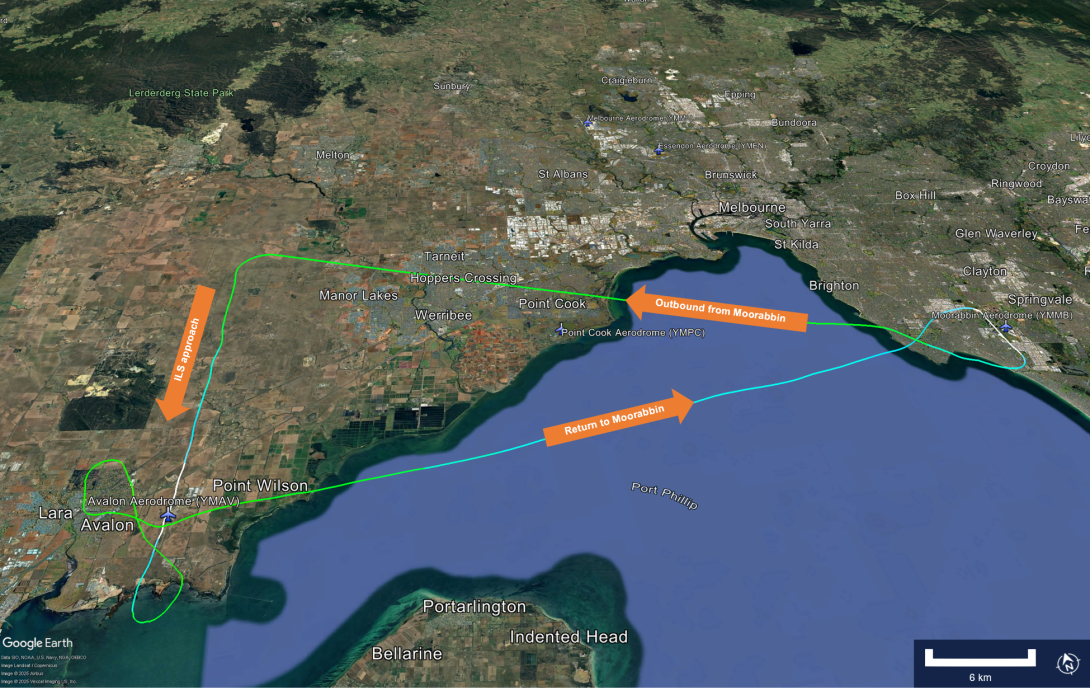What happened
On 22 May 2025, a commercially licenced (CPL) pilot was undergoing an examination for the initial issue of a multi-engine instrument rating. Around 1200 local time, upon completion of the examination ground components, the candidate boarded the aircraft (left front seat), alongside the certified examiner (right front seat) and an observing examiner (right rear seat). Take-off from Moorabbin Airport was routine, and the aircraft tracked for an instrument landing system (ILS) approach at Avalon Airport, Victoria, followed by a planned VHF omni-range (VOR) approach to runway 18.
Both examining officers reported that the pilot’s performance began to noticeably deteriorate following a simulated engine failure and the missed approach component of the flight test, with increasing inaccuracy in tracking and altitude holding and a loss of situational awareness described by both examiners. Subsequently, after the principal examiner discontinued the flight test, both officers became aware that the pilot was now sweating profusely and not responding verbally. Shortly thereafter, the pilot lost consciousness.
The principal examiner assumed control of the aircraft and advised Avalon Approach air traffic control (ATC) of the situation and the intent to return to Moorabbin. Moorabbin Tower ATC provided taxi guidance for the arrival to facilitate transfer of the candidate pilot to an ambulance. Both examiners worked to ensure the pilot’s arms and legs were away from the aircraft controls and their headset and instrument hood were removed. They both noted that in the DA 42, the aircraft’s seats were fixed and not able to be moved rearwards for better control clearance.
Landing at Moorabbin was uneventful, with the aircraft met by the Aerodrome Reporting Officer (ARO). Shortly thereafter, the candidate pilot regained consciousness and was able to climb unaided from the aircraft to meet the ambulance staff.
The candidate pilot reported that they had not eaten anything substantial on the day of the examination and had only 4 hours sleep in the preceding 24 hours, with a total of 10 hours in the past 2 days.
Figure 1: Flight path – flight test and return to Moorabbin

Source: Google Earth, with track data from FlightRadar24 (https://www.flightradar24.com), annotated by the ATSB
Safety message
Both mentally and physically, flight examinations can be taxing for the candidate. Demanding concentration and focus – often for extended periods, these assessments require that pilots’ preparation also extends to their physiological readiness, if best performance and safety is to be assured.
The value and importance of Crew Resource Management (CRM) is most often discussed and considered in terms of larger passenger-carrying aircraft operations. This occurrence – specifically the cooperation displayed by the principal and observing examiners in ensuring the candidate pilot was safe and the aircraft controls uninhibited – illustrates that the principles of CRM extend to all multi-crew situations.
About this report
Decisions regarding whether to conduct an investigation, and the scope of an investigation, are based on many factors, including the level of safety benefit likely to be obtained from an investigation. For this occurrence, no investigation has been conducted and the ATSB did not verify the accuracy of the information. A brief description has been written using information supplied in the notification and any follow-up information in order to produce a short summary report, and allow for greater industry awareness of potential safety issues and possible safety actions.


